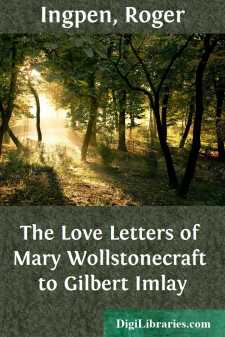Categories
- Antiques & Collectibles 13
- Architecture 36
- Art 48
- Bibles 22
- Biography & Autobiography 813
- Body, Mind & Spirit 142
- Business & Economics 28
- Children's Books 15
- Children's Fiction 12
- Computers 4
- Cooking 94
- Crafts & Hobbies 4
- Drama 346
- Education 46
- Family & Relationships 57
- Fiction 11828
- Games 19
- Gardening 17
- Health & Fitness 34
- History 1377
- House & Home 1
- Humor 147
- Juvenile Fiction 1873
- Juvenile Nonfiction 202
- Language Arts & Disciplines 88
- Law 16
- Literary Collections 686
- Literary Criticism 179
- Mathematics 13
- Medical 41
- Music 40
- Nature 179
- Non-Classifiable 1768
- Performing Arts 7
- Periodicals 1453
- Philosophy 64
- Photography 2
- Poetry 896
- Political Science 203
- Psychology 42
- Reference 154
- Religion 513
- Science 126
- Self-Help 84
- Social Science 81
- Sports & Recreation 34
- Study Aids 3
- Technology & Engineering 59
- Transportation 23
- Travel 463
- True Crime 29
The Love Letters of Mary Wollstonecraft to Gilbert Imlay
by: Roger Ingpen
Description:
Excerpt
I
Of Mary Wollstonecraftâs ancestors little is known, except that they were of Irish descent. Her father, Edward John Wollstonecraft, was the son of a prosperous Spitalfields manufacturer of Irish birth, from whom he inherited the sum of ten thousand pounds. He married towards the middle of the eighteenth century Elizabeth Dixon, the daughter of a gentleman in good position, of Ballyshannon, by whom he had six children: Edward, Mary, Everina, Eliza, James, and Charles. Mary, the eldest daughter and second child, was born on April 27, 1759, the birth year of Burns and Schiller, and the last year of George II.âs reign. She passed her childhood, until she was five years old, in the neighbourhood of Epping Forest, but it is doubtful whether she was born there or at Hoxton. Mr. Wollstonecraft followed no profession in particular, although from time to time he dabbled in a variety of pursuits when seized with a desire to make money. He is described as of idle, dissipated habits, and possessed of an ungovernable temper and a restless spirit that urged him to perpetual changes of residence. From Hoxton, where he squandered most of his fortune, he wandered to Essex, and then, among other places, in 1768 to Beverley, in Yorkshire. Later he took up farming at Laugharne in Pembrokeshire, but he at length grew tired of this experiment and returned once more to London. As his fortunes declined, his brutality and selfishness increased, and Mary was frequently compelled to defend her mother from his acts of personal violence, sometimes by thrusting herself bodily between him and his victim. Mrs. Wollstonecraft herself was far from being an amiable woman; a petty tyrant and a stern but incompetent ruler of her household, she treated Mary as the scapegoat of the family. Maryâs early years therefore were far from being happy; what little schooling she had was spasmodic, owing to her fatherâs migratory habits.
In her sixteenth year, when the Wollstonecrafts were once more in London, Mary formed a friendship with Fanny Blood, a young girl about her own age, which was destined to be one of the happiest events of her life. There was a strong bond of sympathy between the two friends, for Fanny contrived by her work as an artist to be the chief support of her family, as her father, like Mr. Wollstonecraft, was a lazy, drunken fellow.
Maryâs new friend was an intellectual and cultured girl. She loved music, sang agreeably, was well-read too, for her age, and wrote interesting letters. It was by comparing Fanny Bloodâs letters with her own, that Mary first recognised how defective her education had been. She applied herself therefore to the task of increasing her slender stock of knowledgeâhoping ultimately to become a governess. At length, at the age of nineteen, Mary went to Bath as companion to a tiresome and exacting old lady, a Mrs. Dawson, the widow of a wealthy London tradesman. In spite of many difficulties, she managed to retain her situation for some two years, leaving it only to attend the deathbed of her mother.
Mrs....


